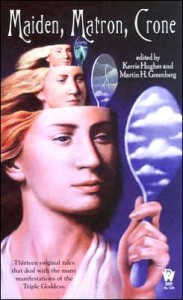 As suggested by the title, this anthology is a collection of thirteen stories all revolving around the age-old concept of the Three-in-One, also known as the Triple Goddess, or the Maiden, Matron (Mother) and Crone. Best associated with Wiccan beliefs, the Triple Goddess can nevertheless be found in any number of old religions and belief systems, such as the Greco-Roman family of myths. With that as their starting block, a baker’s dozen of fantasy authors have turned out some thoughtful stories.
As suggested by the title, this anthology is a collection of thirteen stories all revolving around the age-old concept of the Three-in-One, also known as the Triple Goddess, or the Maiden, Matron (Mother) and Crone. Best associated with Wiccan beliefs, the Triple Goddess can nevertheless be found in any number of old religions and belief systems, such as the Greco-Roman family of myths. With that as their starting block, a baker’s dozen of fantasy authors have turned out some thoughtful stories.
In Brenda Cooper’s “A Lingering Scent of Bacon,” a teenage runaway has some unusual encounters along the way, leading her to realize that the journey is just as important as the destination, but regardless, she needs to know when to stop running. But who, or what, is guiding her steps and keeping her from harm?
Tanya Huff’s “Choice of Ending” revisits a popular secondary character from one of her earlier urban fantasy novels. Mrs. Ruth is an eccentric bag lady who just happens to be the current avatar for the Crone aspect of the Triple Goddess, accustomed to making sure people meet their karmic destinies. But how will she react when her time draws closer to an end? Will she go gently into the night, or will she kick and scream the whole way? The way she tackles the last moments of her life provide a fascinating coda to Huff’s earlier work, Gate of Darkness, Circle of Light.
Nina Kiriki Hoffman’s “Strikes of the Heart” follows a young woman whose unusual relationship with a spirit of nature has earned her the title of “plantwife.” As she watches her grandmother, a powerful magical defender for a kingdom, sink further into absent-minded carelessness due to age, Kishi must embrace an unexpected legacy.
Jean Rabe’s “Misery and Woe” is a story with a bitterly ironic twist to it. Though no longer young, the witch known as Elspeth finds her efforts to help a village hampered by her own considerable physical assets. Harassed by men too busy staring at her chest to hold a proper conversation and shunned by the women of the village for what their men are doing, Elspeth may not be able to save her new home from tragedy. Should she even try?
In “In Sight,” Charles de Lint follows a folk singer who’s found herself at a crossroads relatively late in life. When she meets a young musician just starting out on the same road, they may be able to share the wisdom, at least for a while.
Jody Lynn Nye’s “The Gift” is the story of a fickle young woman whose encounter with a goddess of the hunt helps her to realize what she’s been doing wrong in her relations with other people. “Bearing Life,” by Devon Monk looks at the widowed queen of a beleaguered kingdom, one who has to make some drastic, powerful decisions on the eve of her land’s potential downfall. To save her people and her land, what will she give up, and to whom?
Rosemary Edghill tells another story of her urban witch, Bast, in “Advice From A Young Witch To An Old Priestess,” recounting the earlier days of Bast’s time in New York and her introduction to Wiccan politics and ways. Alexander B. Potter’s “Opening Her Door” looks closely at a young man with a calling unusual for his gender. Called by the Goddess to serve her, will he have the strength to go against his family’s wishes, and his culture’s expectations?
Stories by Fiona Patton, Russell Davis, Jane Lindskold, and Michelle West complete this volume. All in all, I found Maiden, Matron, Crone fairly satisfying, even if some of the stories seemed to lose track of the theme (or at least not address it too specifically). Huff’s story is definitely one of the strongest of an eclectic mix. Rosemary Edghill’s story, like all of her Bast stories, barely skirts upon fantasy at all, leaving the supernatural aspects and their implications to the reader. However, I’d have to say that on the whole, there’s enough here to satisfy the theme, and some very good stories by top-notch authors make this worth checking out.
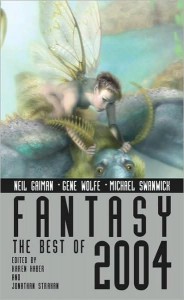 Fantasy: The Best of 2004, edited by Karen Haber and Jonathan Strahan (iBooks, 2005)
Fantasy: The Best of 2004, edited by Karen Haber and Jonathan Strahan (iBooks, 2005)
Science Fiction: The Best of 2004, edited by Karen Haber and Jonathan Strahan (iBooks, 2005)
That’s right, it’s that time of the year already, and the first of the “Best of” collections have started appearing on the shelves. I really must commend Karen Haber and Jonathan Strahan for managing to get this pair of anthologies out so quickly. As you can imagine, they’ve sorted through the hundreds of short fiction pieces published in 2004, and present for our enjoyment the stories they consider to be the best representation of last year’s highlights. Unlike some of the collections that will appear later in the year, these particular volumes only offer about a dozen stories for each genre, which leads to some interesting, and entertaining choices.
The Fantasy volume starts off with Neil Gaiman’s “Forbidden Brides of the Faceless Slaves in the Nameless House of the Night of Dread Desire,” a neo-Gothic tale which definitely wins out for longest title. Michael Swanwick, who appears quite regularly in these sorts of collections, is here as well with “The Word That Sings the Scythe.” It’s likewise no surprise to see Peter Beagle with “Quarry,” Gene Wolfe with “The Little Stranger,” or Robert Silverberg’s “The Sorcerer’s Apprentice.” The prolific Jay Lake is represented by “The Angel’s Daughter,” while World Fantasy Award winner Jeffrey Ford is in here with “The Annals of the Eelin-Ok.”
To finish things off are Kelly Link’s “The Faery Handbag,” Elizabeth Lynn’s “The Silver Dragon,” Tim Powers’ “Pat Moore,” and Deborah Roggie’s “The Enchanted Trousseau.”
For those keeping score at home, that lineup includes two stories from F&SF, two from The Faery Reel (edited by Ellen Datlow and Terri Windling), and three from Flights: Extreme Visions of Fantasy (edited by Al Sarrantonio.) Weighing in at one representative each are Lady Churchill’s Rosebud Wristlet, Realms of Fantasy, and Gothic! It’s always interesting to see where the best stories of any given year are drawn from, and I’m certainly not surprised to see Flights or Faery Reel included here.
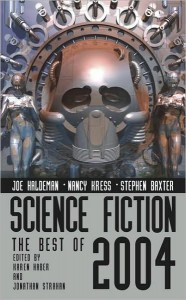 Over in the Science Fiction volume, Gene Wolfe makes a second appearance wirh “The Lost Pilgrim,” while Joe Haldeman’s “Memento Mori,” James Patrick Kelly’s “The Best Christmas Ever,” Stephen Baxter’s “PeriAndry’s Quest,” and “The Voluntary State” by Christopher Rowe join it. Also to be found are “Three Days in a Border Town” by Jeff VanderMeer, “My Mother Dancing” by Nancy Kress,” “Elector” by Charles Stross, “Tourists” by M. John Harrison, “All Of Us Can Almost…” by Carol Emshwiller, “The Tang Dynasty Underwater Pyramid” by Walter Jon Williams, and Paolo Bacigalupi’s “The People of Sand and Slag.”
Over in the Science Fiction volume, Gene Wolfe makes a second appearance wirh “The Lost Pilgrim,” while Joe Haldeman’s “Memento Mori,” James Patrick Kelly’s “The Best Christmas Ever,” Stephen Baxter’s “PeriAndry’s Quest,” and “The Voluntary State” by Christopher Rowe join it. Also to be found are “Three Days in a Border Town” by Jeff VanderMeer, “My Mother Dancing” by Nancy Kress,” “Elector” by Charles Stross, “Tourists” by M. John Harrison, “All Of Us Can Almost…” by Carol Emshwiller, “The Tang Dynasty Underwater Pyramid” by Walter Jon Williams, and Paolo Bacigalupi’s “The People of Sand and Slag.”
Originwise, SciFiction takes the lead with four stories, F&SF has two, as does Asimov’s. Analog, Amazing Stories, Polyphony 4, and The First Heroes (edited by Harry Turtledove) all have but one story each. The most unusual source, however, has to be “Tourists,” which was published on Amazon.com of all places. While the Fantasy volume was roughly half-and-half with regards to magazines versus books, the SF volume is split half-and-half between online sources and print.
Any “Best of…” collection is subjective. Were I to assemble a collection, it would undoubtedly be quite different. My tastes run to a different kind of story than many of those found here; if I’d placed money on which stories I’d see collected, I’d probably have to borrow cabfare for the ride home. But there’s no disputing that Haber and Strahan have assembled an excellent pair of anthologies, and you could easily use these two books to show off some of the most interesting, thoughtful, imaginative, or just plain out-there stories of 2004. Your mileage will vary, but I was quite pleased with what I found here. If you missed these stories when they first came out, now’s a good chance to catch up.
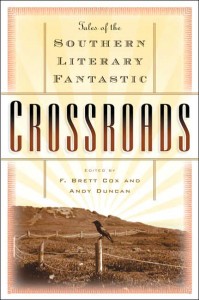 This is actually something of an interesting mixed bag. Crossroads was an attempt to invoke a certain sense of style and atmosphere by collecting stories and short pieces about the American South, honoring authors such as William Faulkner, Mark Twain, Manly Wade Wellman, Edgar Allen Poe and others. In short, stories where the South itself was as much a character as a setting, where the regional attitudes influenced the course of the story, and where fantasy and reality crossed over one another. As a result, what you’ll find here is a fantasy anthology that’s far more “mainstream” or “literary” than many of its colleagues, containing stories quite suitable for teaching in university English classes years from now. These are imaginative, strange, and quite varied. Some stories are all-new for this volume, a number of offerings are reprints , though none older than 1988. Some of the authors are quite well-known in the fantasy field, while others are relative newcomers. What they all have in common is an identification with the South, living in that area and having an empathy for the area’s particular feel. As a result, it’s hard to truly classify this collection. You could just as easily find this book in the fantasy section as you could the fiction section, or, should your store be in the South, perhaps the regional interests section.
This is actually something of an interesting mixed bag. Crossroads was an attempt to invoke a certain sense of style and atmosphere by collecting stories and short pieces about the American South, honoring authors such as William Faulkner, Mark Twain, Manly Wade Wellman, Edgar Allen Poe and others. In short, stories where the South itself was as much a character as a setting, where the regional attitudes influenced the course of the story, and where fantasy and reality crossed over one another. As a result, what you’ll find here is a fantasy anthology that’s far more “mainstream” or “literary” than many of its colleagues, containing stories quite suitable for teaching in university English classes years from now. These are imaginative, strange, and quite varied. Some stories are all-new for this volume, a number of offerings are reprints , though none older than 1988. Some of the authors are quite well-known in the fantasy field, while others are relative newcomers. What they all have in common is an identification with the South, living in that area and having an empathy for the area’s particular feel. As a result, it’s hard to truly classify this collection. You could just as easily find this book in the fantasy section as you could the fiction section, or, should your store be in the South, perhaps the regional interests section.
But what of the stories? Well, there are those that stand out. Bud Webster turns in a thoughtful piece about an old man who’s lived past his prime, yet isn’t allowed to die, in “Christus Destitutus.” It’s a sharp, moody look at faith, obligation, duty, and the heavy burdens some of us must bear. Don Webb turns in a dreamlike, multilayered quest for truths and mysteries, in “Ool Athag,” a fantasy tale that meanders through various realms as it searches for the origin of something buried in the far past.
Some stories aren’t really even fantasy at all. Michael Bishop’s “The Yukio Mishima Cultural Association of Kudzu Valley, Georgia,” is the account of a semi-disgraced academic seeking refuge and redemption in a small town. However, when he accidentally introduces a new kind of foreign culture into their midst, he can’t even begin to imagine the consequences that soon follow. Like a catastrophic game of dominos, it all comes tumbling down faster than he can stop it. Michael Swanwick, whose literature has cut an award-winning swath through the field, gives us a short, poignant story, more essay than fiction, entitled “The Last Geek.” In it, one man, the last of his kind, tours the country, giving talks about his old life, and demonstrating his profession one last time for shocked and amazed audiences.
In “Slippered Feet,” by Daniel Wallace, an older couple decide to go on a vacation to somewhere far away and exotic, perhaps an island. They take up language lessons at night, hoping to get a feel for their destination’s language and culture. However, when one of them becomes far more adept at understanding the new language than her husband, it drives an eerie wedge between them. Lynn Pitts’ “Tchoupitoulas Bus Stop” is a New Orleans ghost story, filled with yearning and tragedy, and coming to an uneasy, unsettling resolution.
Other authors present include Andy Duncan, Gene Wolfe, Scott Edelman, Bret Lott, Kelly Link, and Jack McDevit. All in all, a wonderfully diverse collection of Southern tales that will certainly appeal to the literary-inclined, cerebral reader. I enjoyed checking this collection out, but I will confess that a number of stories just didn’t catch me. As stories of the “Southern literary fantastic” go, however, this is an excellent anthology.
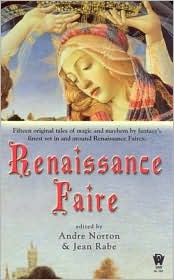 There’s nothing quite like a Renaissance Faire. The crowds, the jousting, the meat on a stick, the mangled accents, the lovely costumes and chainmail bikinis, the people playacting at a fantasized, idealized past. In this imaginative anthology, sixteen authors turn their creative attentions towards exploring what bizarre secrets and magical mysteries these Faires might hold. Now, apart from Mercedes Lackey’s Knight of Ghosts and Shadows, I can’t think of too many fantasy books to take advantage of the potential of Renn Faires, so it’s good to see someone giving the concept some in-depth consideration, if just because it’s perfect for a wide variety of takes, both serious and less-than-serious.
There’s nothing quite like a Renaissance Faire. The crowds, the jousting, the meat on a stick, the mangled accents, the lovely costumes and chainmail bikinis, the people playacting at a fantasized, idealized past. In this imaginative anthology, sixteen authors turn their creative attentions towards exploring what bizarre secrets and magical mysteries these Faires might hold. Now, apart from Mercedes Lackey’s Knight of Ghosts and Shadows, I can’t think of too many fantasy books to take advantage of the potential of Renn Faires, so it’s good to see someone giving the concept some in-depth consideration, if just because it’s perfect for a wide variety of takes, both serious and less-than-serious.
Elizabeth Ann Scarborough’s “Jewels Beyond Price” brings a little bit of Aladdin into the Faire, when a jeweler stumbles across a lamp-shaped lighter, complete with its own personal genie. Unfortunately, the lighter’s previous owner realizes his loss, and comes looking for it. It’s an interesting showdown, with royalty in attendance. Joe Haldeman’s “Diminished Chord” is somewhat morose, something of a ghostly romance with a not-so-happy ending. In “Splinter,” Kevin J. Anderson and Rebecca Moesta chronicle the tale of a pickpocket who’s about to lift more than he ever expected from one man’s pocket, an encounter which will change his life forcibly. It’s a morality tale, one that quite clearly lays out the consequences for doing the right thing and the wrong thing.
Robert E. Vardeman’s “A Time For Steel” looks at the beginning of a legend which will last for centuries, whose origins lie in modern times, and whose culmination lies in the Dark Ages. In Jayge Carr’s “Wimpin’ Wady,” an overzealous member of the Fae kidnaps the wrong child, earning the desperate ire of the child’s mother. Esther Friesner turns in what might very well be the funniest piece of the book, in “Marriage a la Mordred.” When some idle playacting accidentally binds one of the Fae to a teenage girl, the immortal Lord of Faerie learns to his dismay just how temperamental, stubborn, resourceful, and incomprehensible mortal teenagers can be. The results are hilarious, as always when Friesner turns her hand to comedy.
Roberta Gellis’ “Moses’ Miracles” looks at a billionaire and his faithful curator/librarian. It seems that they’ve acquired an item of great age and tremendous mystical importance, and an otherworldly race needs their help, but will the cost be too high to bear? Of all the stories in this book, this one is the one that most deserves to be followed up upon, as there’s clearly a lot more to be explored with these characters. Stephen Sullivan’s “Renaissance Fear” is one of the darkest pieces to be found here, looking at a young couple who become caught between the present and the past, with deadly consequences. Brian Hopkins’ The Land of the Awful Shadow” is an introspective story, flashing between childhood and adulthood for a couple of friends who share a number of secrets, and a bond which unites them across the decades.
As with any themed anthology, you’ll find a wide range, both in tone and in style. For the most part, Renaissance Faire is a nice collection of satisfying stories, sticking fairly close to the theme without being overly repetitive. I was rather pleased with the overall content.
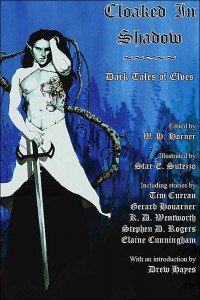 Cloaked in Shadow is the first themed anthology offering from the relatively new Fantasist Enterprises (www.fantasistent.com). With almost two dozen stories featuring the darker side of elves and fairies, it definitely has a little something for everything, though in general, what you’ll find here tends to hew towards a dark fantasy bordering on outright horror, thus proving that elves don’t always have to be happy and shiny.
Cloaked in Shadow is the first themed anthology offering from the relatively new Fantasist Enterprises (www.fantasistent.com). With almost two dozen stories featuring the darker side of elves and fairies, it definitely has a little something for everything, though in general, what you’ll find here tends to hew towards a dark fantasy bordering on outright horror, thus proving that elves don’t always have to be happy and shiny.
I have to admit, I was unfamiliar with many of the authors present in this collection, so I really didn’t know what to expect from the stories within. It’s an interesting mix, with some rather memorable stories, some which really convey a lingering dark feeling. Three of them – Erin MacKay’s “Diminishing,” H. Turnip Smith’s “Evil Lives, Vice Eats Simplicity,” and K.D. Wentworth’s “Bad Company” – all deal with mortal police running afoul of elven crimes or mischief, though MacKay’s story is a homicide investigation, Wentworth’s involves a murder on the job, and Smith’s is … hard to explain. In all three cases, things don’t go well for the human involved. In John Sullivan’s “Under Distant Hills,” a woman makes a fateful deal with the elves, sacrificing her future to insure her success in the present, a deal which works out well for the long-term-planning of the elves. J.R. Cain’s “The Suitcase” reads like a cross between True Romance and Tam Lin: when a loser finds a suitcase full of money, he and an old friend and her baby are drawn into a bizarre plot involving elves, cat-fairies, and lots of gunplay. “Rotten Blood,” by Murray Leeder, looks at the last moments of immortality for one race of elves, as the true implications of unchanging eternity are brought to light. Stephen D. Rogers gives us “Laume’s Lesson,” a rather short, viciously-to-the-point story of how elves reward kindness and punish greed.
All in all, Cloaked in Shadow succeeds in delivering some rather dark, disturbing tales involving the elves, mixing science fiction, fantasy, and urban fantasy to produce an interesting assortment. An overuse of pseudo-Gothic lettering used in the font for the cover, table of contents, and page headers does make it occasionally hard to read the names of stories or authors, and I’m not entirely sure what the half-naked elf on the cover is doing with the sword, or what exactly he’s actually wearing, so I do have to subtract points for the presentation. Hopefully future anthologies will have a more polished appearance as the publisher establishes more of a presence in the marketplace. This collection is worth picking up, however, if you enjoy dark fantasy or the nastier side of elves.
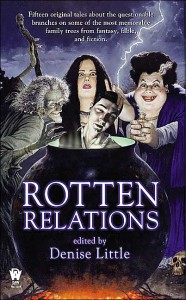 Just in time for the holidays, we have this lovely anthology, which puts the matter of family into a whole new perspective. Think you might have trouble with your drunken Uncle Gary, who retells the same old stories every year? He can’t stack up to Hamlet’s uncle Claudius, who murdered his brother and married his brother’s wife … or so the story claims. How about that mother your dad married, who tries too hard to be your friend? She’s nothing compared to Cinderella’s stepmother … or is she? Fifteen stories in all retell some very famous fairy tales, fictional accounts, and fables from the viewpoint of the previously-maligned.
Just in time for the holidays, we have this lovely anthology, which puts the matter of family into a whole new perspective. Think you might have trouble with your drunken Uncle Gary, who retells the same old stories every year? He can’t stack up to Hamlet’s uncle Claudius, who murdered his brother and married his brother’s wife … or so the story claims. How about that mother your dad married, who tries too hard to be your friend? She’s nothing compared to Cinderella’s stepmother … or is she? Fifteen stories in all retell some very famous fairy tales, fictional accounts, and fables from the viewpoint of the previously-maligned.
In Pauline J. Alama’s “Home for the Holidays,” a father and son attempt to find common ground, amidst the father’s workaholic schedule and the son’s teenage rebellion. The twist here is that the father is Santa Claus, who’s taken on more work than he really needs over the centuries, and quality time with the family has suffered as a result. A clever story, it updates the Santa myth with some modern sensibilities to fit in with the 21st century. “With A Face Only A Mother Could Love,” by Jenn Reese, revisits Grendel from the viewpoint of the monster and his mother, likewise turning it into a tale about an estranged father and son. In “Switched,” Nina Kiriki Hoffman, always good for an introspective, quietly magical story, retells Cinderella, though she turns the tables on both protagonist and “wicked” stepsister. “The Trick of the Tricksters Tricked,” by Josepha Sherman, is a retelling of a classic Coyote story in which the chaotic trickster god runs afoul of a spider trickster and his wife, and it’s anyone’s guess as to who will prevail in a war of pranks.
Bill McCoy turns Sleeping Beauty into a political satire/courtroom comedy with “Dynasty,” a quick story with some very familiar faces to be found. Meanwhile, Cinderella gets a makeover from the viewpoint of the stepmother, in Bradley and Susan Sinor’s “Serpent’s Tooth.” The third and last exploration of the Cinderella story comes in “After the Ball,” by Pamela Luzier, in which the wicked stepmother and her worthless daughters try one last time to get what they think they deserve out of Cinderella’s happy circumstances, and end up in an entirely different predicament by the end. Devon Monk’s “Peggy Plain” is a highly imaginative look at some old nursery rhymes, set in a magical place called Las Fables, where anything goes and everyone’s looking for an angle, or a rhyme.
For a look between the pages of a classic novel, turn to David Bischoff’s “Heathcliff’s Notes,” a metatextual adventure written from the viewpoint of the champion brooder himself and former star of Wuthering Heights. P.N. Elrod attempts to exonerate Claudius and prove who really killed the King of Denmark, in “King of Shreds and Patches,” and the answer may not be who you think it is.
As with any themed anthology, there’s a wide mix of stories to choose from. Happily, I’d have to say that in general, the stories in Rotten Relations do a great job of finding new things to say about their source materials and inspiration. It’s definitely worth picking up, especially if you’ve enjoyed previous DAW offerings like Little Red Riding Hood in the Big Bad City, or The Magic Shop.
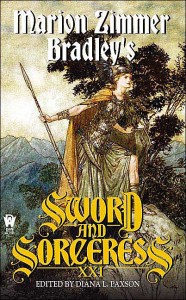 With this volume, the groundbreaking anthology of feminist fantasy created by Marion Zimmer Bradley reaches twenty-one, thus making it one of the longest-running anthology series in the field, as well as allowing it to drink legally in the United States. This is a landmark volume in another way, being the first in the series not to bear any of Bradley’s hand’s-on influence. Rather, her influence is seen here only in the legacy she’s left behind, and in her chosen successor, Diana L. Paxson, who does an admirable job of hewing to the standards established in previous editions, while looking to the future and the long-term viability of the series. The first Sword and Sorceress appeared in 1984, when the fantasy field looked quite different from it does now, and two decades later, it’s impressive that the series has persevered. While the necessity of the Sword and Sorceress franchise may be questionable these days, given that you can’t swing a dead Evil Overlord without hitting a strong female protagonist (such as Jacqueline Carey’s Phedre), and it’s even spawned a humorous response (in Esther Friesner’s Chicks in Chainmail series), it’s nice to see there’s still a place for short fantasy fiction with a female perspective.
With this volume, the groundbreaking anthology of feminist fantasy created by Marion Zimmer Bradley reaches twenty-one, thus making it one of the longest-running anthology series in the field, as well as allowing it to drink legally in the United States. This is a landmark volume in another way, being the first in the series not to bear any of Bradley’s hand’s-on influence. Rather, her influence is seen here only in the legacy she’s left behind, and in her chosen successor, Diana L. Paxson, who does an admirable job of hewing to the standards established in previous editions, while looking to the future and the long-term viability of the series. The first Sword and Sorceress appeared in 1984, when the fantasy field looked quite different from it does now, and two decades later, it’s impressive that the series has persevered. While the necessity of the Sword and Sorceress franchise may be questionable these days, given that you can’t swing a dead Evil Overlord without hitting a strong female protagonist (such as Jacqueline Carey’s Phedre), and it’s even spawned a humorous response (in Esther Friesner’s Chicks in Chainmail series), it’s nice to see there’s still a place for short fantasy fiction with a female perspective.
However, I found myself somewhat underwhelmed by this particular collection of stories. It’s not that they were bad; rather, very few actually appealed to me in terms of tone or theme. Paxson may have tried a little too hard to stick to the criteria first established by Bradley, and some of the stories came off either bland or generic, taking themselves way too seriously. Some did catch my attention, though. Jim C. Hines’ “Spell of the Sparrow” looks at domestic bliss gone awry, as a spellcasting interloper threatens to shatter a family forever, unless the protagonist can save her husband through quick wits and timely action. Naomi Kritzer returns to the setting of her first book, Fires of the Faithful, in “Kin.” A war-weary mage is forced to choose between the magic that is her life, and the orphaned infant whose life depends upon her, a choice that could haunt her for the rest of her days. Jenn Reese turns in an intriguing story about vengeance and family and a woman possessed by a very demanding bear-spirit in “Ursa.” Kit Wesler’s “Red Caramae” examines the lengths to which one frustrated would-be magician would go to in order to gain revenge on those who rejected her. Lee Martindale’s “Necessity and the Mother” is an entertaining look at what happens when a town relies too strong upon its magicians, and offends the mercenaries who normally keep it safe. Terry McGarry returns to the land of Eiden Myr in “Kazhe’s Blade,” telling an untold story of a forgotten, tired heroine.
. While almost all of the contributors to this volume are Sword and Sorceress veterans, or alumnae of MZB’s other endeavors (such as the sadly defunct Marion Zimmer Bradley’s Fantasy Magazine and the Darkover series), newcomers such as Marie Loughlin and K.A. Laity prove the door’s still open to fresh blood. Ultimately, Sword and Sorceress XXI is a worthy addition to the series, with some rather nice stories standing out from an otherwise satisfactory mixture. There’s a little something for everyone here, and it’s good to see the series still has life to it.
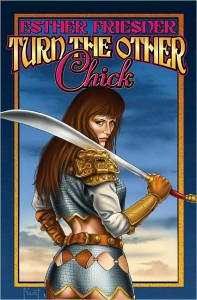 I find it fitting that I review this particular book in the same column as the newest Sword and Sorceress, given that the Chicks series is, in some ways, a direct response not only to the feminist focus of S&S, but the much-mocked “chainmail bikini” theme that become such a staple of the fantasy field for many years. Happily, it looks as though there’s still a call for humorous female fantasy fiction, as this volume marks the fifth in the series. You’ll find no shrinking violets here, no delicate damsels in distress, no fainting flowers of femininity. Rather, these heroines shatter expectations and violate conventions gleefully.
I find it fitting that I review this particular book in the same column as the newest Sword and Sorceress, given that the Chicks series is, in some ways, a direct response not only to the feminist focus of S&S, but the much-mocked “chainmail bikini” theme that become such a staple of the fantasy field for many years. Happily, it looks as though there’s still a call for humorous female fantasy fiction, as this volume marks the fifth in the series. You’ll find no shrinking violets here, no delicate damsels in distress, no fainting flowers of femininity. Rather, these heroines shatter expectations and violate conventions gleefully.
You want oversized heroines? Try Lee Martindale’s “Combat Shopping” or Yvonne Coats’ “She Stuffs To Conquer.” How about senior citizen heroines who refuse to settle down and grow old gracefully? Try Jim C. Hines’ “Over the Hill.” A heroine whose sense of honor extends to protecting whoever asks her properly, even if that would-be client is a cat? Jody Lynn Nye’s “Defender of the Small” is the place to look. Eric Flint skewers the sexist stereotypes of the Norse myths in “The Truth About the Gotterdammerung.”
Several stories are unofficial sequels to much older works of fiction: Laura Frankos returns to Shakespeare’s faeries in “A Late Symmer Night’s Battle,” while Esther Friesner revives the tale of David and Goliath with a major twist, in “Giants in the Earth.” Michael Turner’s “Psyched Up” is an unusual take on the “actor is mistaken for the character they play” theme, and John Hemry takes on the “writer follows their Muse” theme that most editors would rather kill than see again, in “Mightier than the Sword.” Luckily, his take on the whole thing is fresh enough that he gets away with it.
For most unusual heroine, turn to Catherine Shaffer’s “The Gypsy Queen,” where the heroine’s identity is at distinct odds with her true nature. In “I Look Good,” Selina Rosen’s heroine is an evil sorcerer’s minion whose lack of job security causes her to take drastic measures. For best title, the award is tied between “Hallah Iron-Thighs and the Hall of the Puppet King” by K.D. Wentworth, and Robin Wayne Bailey’s “Princess Injera Versus the Spanakopita of Doom.”
Harry Turtledove’s “Of Mice and Chicks” reimagines a literary classic with a female fantasy twist.
However, while the vast majority of the stories in Turn the Other Chick are highly amusing, and certainly entertaining, it’s the published debut of “Very Secret Diaries” author Cassandra Claire that really adds the cherry to the sundae. “The Girl’s Guide to Defeating the Dark Lord” truly captures the book’s mission: to turn all those old fantasy cliches inside out and look at them in a new, humorous light. She may very well have turned in the ideal “Chicks in Chainmail” story. I look forward to seeing Cassandra Claire’s future published works.
I quite happily recommend Turn the Other Chick. It’s a hardcover anthology – a hardcover humorous fantasy anthology – that’s well worth the cover price, with hardly a letdown in the lot, and some top-notch authors having more than their fair share of fun in the process.
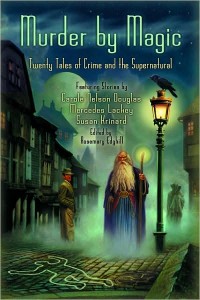 As with Powers of Detection, which I covered several months ago, Murder by Magic mixes the fantasy and mystery genres for some interesting results. Twenty authors present their characters with magical, murderous dilemmas to solve, divided into five categories: modern, fantastical, historical, genteel, and unclassifiable.
As with Powers of Detection, which I covered several months ago, Murder by Magic mixes the fantasy and mystery genres for some interesting results. Twenty authors present their characters with magical, murderous dilemmas to solve, divided into five categories: modern, fantastical, historical, genteel, and unclassifiable.
Jennifer Roberson’s “Piece of Mind” teams a tired ex-cop with a woman possessed of an unusual affinity for animals to solve not just an old murder, but a secret that’s haunted the narrator for much of his life. It’s an intriguing setup for future stories, and I hope she’ll expand on the idea. “Special Surprise Guest Appearance by…” by Carole Nelson Douglas takes a look at the strong rivalry between several Las Vegas magicians, and the secrets one utilizes in her act. In “Doppelgangster,” Laura Resnick mixes the supernatural and the Mob for a somewhat tongue-in-cheek effect. If certain wiseguys are getting whacked, how can they be seen, alive and well hours or days later? And who’s killing them to begin with? Josepha Sherman’s “The Case of the Headless Corpse” introduces Raven and Coyote, agents of the Magical Bureau of Investigation. When they attempt to delve into the cause of death for the titular victim, their investigation leads them to a most unexpected culprit. The partners work well together, with a great sort of chemistry, and hopefully this won’t be their only appearance.
Diane Duane’s “Cold Case” showcases a policeman with a truly difficult job to do: work with the ghost of an elderly murder victim to determine who killed her and why, so she can move on to the next world. But the cop’s job may be harder than he expected, especially when the truth comes to light. While the way this story plays out wasn’t entirely unexpected, it’s still poignant and well-told, and it lends itself well to further exploration. Laura Anne Gilman seems to be turning up all over the place of late, and I couldn’t be happier. She’s always good for an entertaining story, especially if she’s focusing on Wren and Sergei, the main characters of her first novel, Staying Dead, as she is here in “Overrush.” Someone’s killing wizzarts, those magically-inclined people whose powers have driven them nuts, preying on a part of the magical population prone to accidents, burnout, and untimely ends. But who, and why? It almost pains me to note that Gilman doesn’t so much resolve this story as bring it to a close, leaving plot threads open for future development somewhere down the line. As a stand-alone story, it lacks closure, which is a real disappointment, as it’s otherwise a great effort. I love how Wren and Sergei work with each other, a partnership that threatens to become more, but both Staying Dead and Gilman’s contribution to Powers of Detection are better examples of her work than “Overrush.”
Sharon Lee and Steve Miller turn in “A Night at the Opera,” a clever tale highly reminiscent of the Thin Man series (right down to main characters named Nick and (De)nora). When a noted practitioner of magic turns up dead, with no clues as to who did it, Nick and Nora have to unravel the mystery. However, they may not be prepared for what they find, or how it all plays out, and what it means for the magical society they belong to. Lawrence Watt-Evans gives us “Dropping Hints,” where a young Duke must figure out which of five identical golems brutally killed its wizard master … right in front of him. Even having witnessed the murder, can the Duke tell one suspect from another in time to do any good? Meanwhile, in “Au Purr,” Esther Friesner focuses on a witch investigating the death of her sister by disguising herself as a housecat. It’s a risky maneuver, fraught with dangers mundane and magical. She’ll have to content with everything from rat traps to demons to piece this mystery together.
In “Getting the Chair,” Keith R.A. DeCandido revisits the heroes of his new novel Dragon Precinct, Danthres and Torin. Once again, these two esteemed members of the Castle Guard have a dirty job to do: this time, figure out who killed a certain mage, as well as how and why. They realize just how bizarre a mystery it really is when the only witnesses worth questioning are the pieces of furniture enchanted into life by the mage prior to his death. This is a good, solid story, a police procedural that really takes advantage of the bizarre twists allowed in a fantasy setting while remaining grounded through good old-fashioned human nature. Torin and Danthres bring an everyman quality to their job that remains true no matter what world you’re on.
Mercedes Lackey looks once again at the unusual inhabitants of Victorian London’s Harton School for Boys and Girls, in “Grey Eminence.” Missionary’s child Sarah, and her best friend, native Londoner Nan, are in great demand for their strange abilities, but most of the time they’re able to keep things subtle and under wraps. However, the arrival of a feathered friend for Nan may change that, or it may just save them when things get really bad. It seems to me it’s been a while since we’ve seen this particular set of characters; I hope it’s not too long before they come back again.
All in all, Murder by Magic has some good stories, and a few excellent ones, making it worth picking up. Mystery and fantasy fans alike will find things to enjoy here.
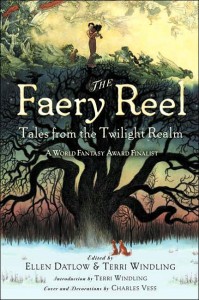 It’s taken me several months just to try and figure out what I want to say about this book. Mainly because it’s one of those rare occasions where I’m afraid that whatever I have to say won’t live up to what I really feel. See, I’ve long been of the opinion that you can’t go wrong with an anthology edited by Terri Windling and Ellen Datlow. Whether it was the first sixteen volumes of the Year’s Best Fantasy and Horror, or the superb series they did of retold fairy tales (starting with Snow White, Blood Red), or even their most recent effort, The Green Man, they’ve constantly put together some of the best fantasy anthologies around. And before this goes any further, no, this isn’t a buildup to me saying something horribly bad about The Faery Reel. On the contrary, it’s so good, I’m almost intimidated. Almost.
It’s taken me several months just to try and figure out what I want to say about this book. Mainly because it’s one of those rare occasions where I’m afraid that whatever I have to say won’t live up to what I really feel. See, I’ve long been of the opinion that you can’t go wrong with an anthology edited by Terri Windling and Ellen Datlow. Whether it was the first sixteen volumes of the Year’s Best Fantasy and Horror, or the superb series they did of retold fairy tales (starting with Snow White, Blood Red), or even their most recent effort, The Green Man, they’ve constantly put together some of the best fantasy anthologies around. And before this goes any further, no, this isn’t a buildup to me saying something horribly bad about The Faery Reel. On the contrary, it’s so good, I’m almost intimidated. Almost.
Much like The Green Man, this is actually a themed anthology aimed at a more YA audience (though with considerable crossover appeal for adult readers as well). Twenty authors have each contributed their takes on the vast and various creatures of the Fae realms, through fiction and poetry, and the lineup reads like the Fantasy All-Stars.
Holly Black, whose own interpretations of Faerie brought us Tithe and The Spiderwick Chronicles, turns in here a reimagining of Christina Rossetti’s “The Goblin Market,” with a Filipino twist in “The Night Market.” Two sisters, a curse, creatures of myth, and a magical market where anything can be bought or sold, if the price is right. “Never Never,” by Bruce Glassco, is a brilliant look at a certain hook-handed pirate, who must battle with feelings of despair and a crisis of faith, while examining the true reasons for the cycle of violence he’s locked into. It takes a lot to make that particular villain sympathetic, but Glassco goes beyond that: he makes Hook into a truly human figure, a tragic sort of villain caught up in something he long ago forgot how to understand. What secret keeps Hook coming back time and again to battle the boy known as Peter, and how does it tie into the true nature of Never Never Land? Quite simply, I was floored by how this story affected me.
Delia Sherman’s “CATNYP” is a fun, whimsical look at a world that exists between the mortal world and the realm of Faerie, where kidnapped humans – changelings – dwell, a magical shadow of New York with its own set of rules. It’s a story about a library, an adventure, some rules, and a stone lion, among other things. “The Faery Handbag,” by Kelly Link, is the story of a young woman, her grandmother, and a magical handbag which contains wonders and mysteries like no other. It’s an introspective story of love and loss, family and magic, and quirky bedtime tales.
I’m almost out of room, and I’ve barely just begun. I mean, I haven’t even touched upon the stories by Tanith Lee, Katherine Vaz, Gregory Frost, or Steve Berman. Discussing the contributions by Emma Bull (whose War For The Oaks is one of the best faerie novels ever), Nina Kiriki Hoffman, Patricia McKillip, Ellen Steiber, or Gregory Maguire could easily double my column’s length. And then there’s poetry by Charles de Lint (a true master in the urban fantasy field) and Neil Gaiman. And how can I neglect to mention the gorgeous artwork by Charles Vess? His illustrations are dead-on perfect, every time. And lest I forget, Terri Windling opens the anthology with one of her trademark essays, a scholarly look at faeries throughout history, and how they’ve interwoven with our culture and our consciousness, and how we’ve woven them into our stories and myths. She looks at how they’ve been treated in recent decades in film and fiction, making note of many of the best offerings to be found along those lines. It’s no coincidence that a number of the authors mentioned make appearances in this collection. Much like DVD extras enhance the film they’re packaged with, so does Windling’s essay add new dimensions to The Faery Reel.
While The Faery Reel is targeted at the young adult audience, there’s more than enough to appeal to older fans as well. Anyone who understands the lure and appeal of Faerie, who enjoys urban fantasy or fairy tales, who’s delighted in movies like Labyrinth or The Dark Crystal, who enjoys the paintings of Brian Froud, or who’s fallen in love with the work of Tennyson should be able to appreciate this book. Windling and Datlow have put together a top-notch collection, one that shouldn’t be missed. I read a lot of anthologies, and this one is easily one of the best I’ve seen all year, in terms of quality, depth, scope, and sheer magic.
